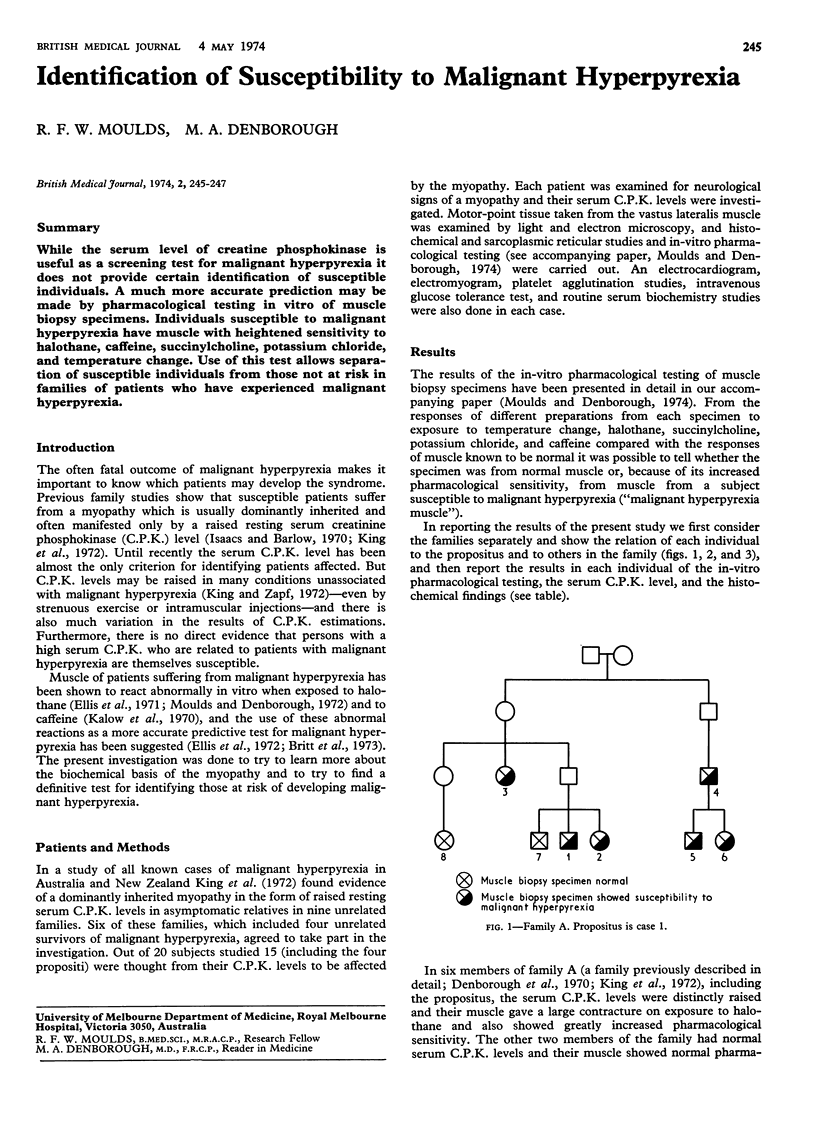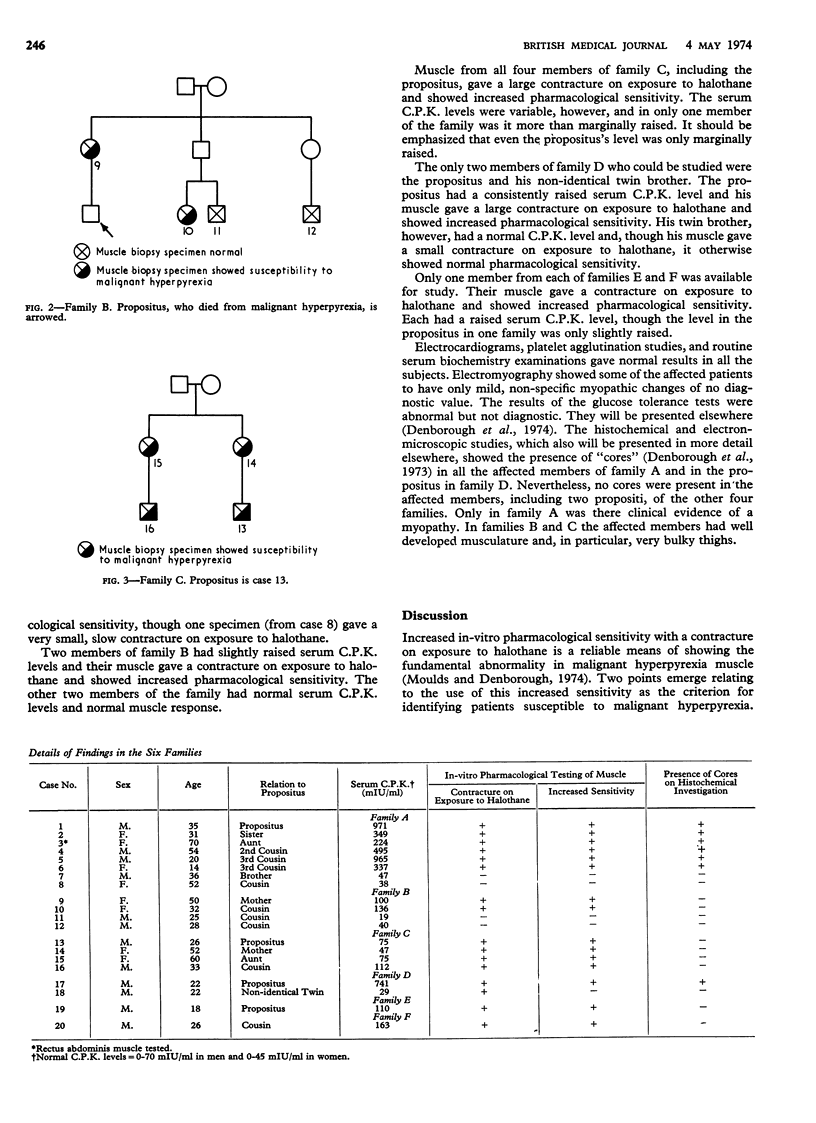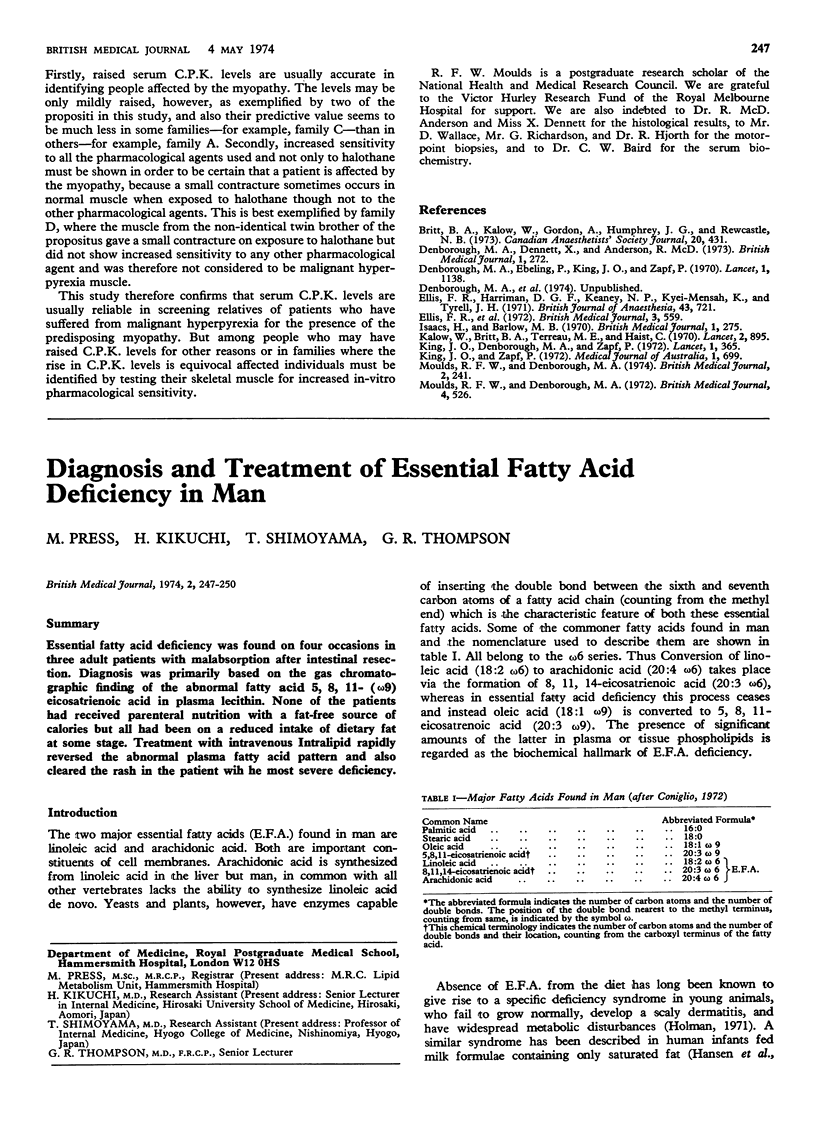Abstract
While the serum level of creatine phosphokinase is useful as a screening test for malignant hyperpyrexia it does not provide certain identification of susceptible individuals. A much more accurate prediction may be made by pharmacological testing in vitro of muscle biopsy specimens. Individuals susceptible to malignant hyperpyrexia have muscle with heightened sensitivity to halothane, caffeine, succinylcholine, potassium chloride, and temperature change. Use of this test allows separation of susceptible individuals from those not at risk in families of patients who have experienced malignant hyperpyrexia.
Full text
PDF


Selected References
These references are in PubMed. This may not be the complete list of references from this article.
- Britt B. A., Kalow W., Gordon A., Humphrey J. G., Rewcastle N. B. Malignant hyperthermia: an investigation of five patients. Can Anaesth Soc J. 1973 Jul;20(4):431–467. doi: 10.1007/BF03026208. [DOI] [PubMed] [Google Scholar]
- Denborough M. A., Dennett X., Anderson R. M. Central-core disease and malignant hyperpyrexia. Br Med J. 1973 Feb 3;1(5848):272–273. doi: 10.1136/bmj.1.5848.272. [DOI] [PMC free article] [PubMed] [Google Scholar]
- Denborough M. A., Ebeling P., King J. O., Zapf P. Myopathy and malignant hyperpyrexia. Lancet. 1970 May 30;1(7657):1138–1140. doi: 10.1016/s0140-6736(70)91215-8. [DOI] [PubMed] [Google Scholar]
- Ellis F. R., Harriman D. G., Keaney N. P., Kyei-Mensah K., Tyrrell J. H. Halothane-induced muscle contracture as a cause of hyperpyrexia. Br J Anaesth. 1971 Jul;43(7):721–722. [PubMed] [Google Scholar]
- Ellis F. R., Keaney N. P., Harriman D. G., Sumner D. W., Kyei-Mensah K., Tyrrell J. H., Hargreaves J. B., Parikh R. K., Mulrooney P. L. Screening for malignant hyperpyrexia. Br Med J. 1972 Sep 2;3(5826):559–561. doi: 10.1136/bmj.3.5826.559. [DOI] [PMC free article] [PubMed] [Google Scholar]
- Isaacs H., Barlow M. B. Malignant hyperpyrexia during anaesthesia: possible association with subclinical myopathy. Br Med J. 1970 Jan 31;1(5691):275–277. doi: 10.1136/bmj.1.5691.275. [DOI] [PMC free article] [PubMed] [Google Scholar]
- Kalow W., Britt B. A., Terreau M. E., Haist C. Metabolic error of muscle metabolism after recovery from malignant hyperthermia. Lancet. 1970 Oct 31;2(7679):895–898. doi: 10.1016/s0140-6736(70)92069-6. [DOI] [PubMed] [Google Scholar]
- King J. O., Denborough M. A., Zapf P. W. Inheritance of malignant hyperpyrexia. Lancet. 1972 Feb 12;1(7746):365–370. doi: 10.1016/s0140-6736(72)92854-1. [DOI] [PubMed] [Google Scholar]
- King J. O., Zapf P. A review of the value of creatine phosphokinase estimations in clinical medicine. Med J Aust. 1972 Apr 1;1(14):699–703. doi: 10.5694/j.1326-5377.1972.tb47015.x. [DOI] [PubMed] [Google Scholar]
- Moulds R. F., Denborough M. A. Biochemical basis of malignant hyperpyrexia. Br Med J. 1974 May 4;2(5913):241–244. doi: 10.1136/bmj.2.5913.241. [DOI] [PMC free article] [PubMed] [Google Scholar]
- Moulds R. F., Denborough M. A. Procaine in malignant hyperpyrexia. Br Med J. 1972 Dec 2;4(5839):526–528. doi: 10.1136/bmj.4.5839.526. [DOI] [PMC free article] [PubMed] [Google Scholar]


